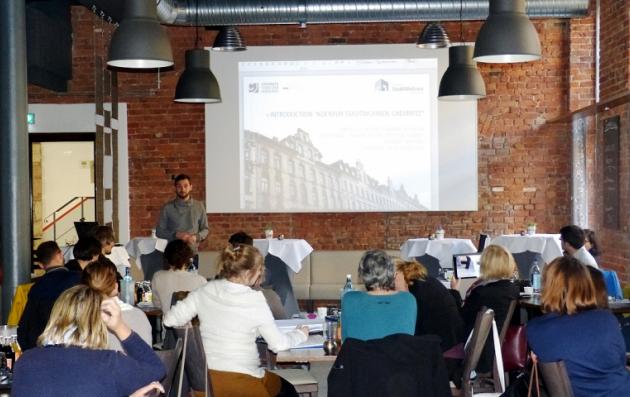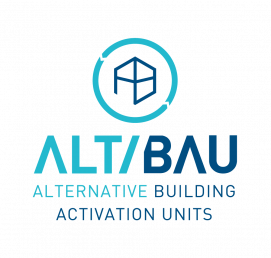Date of label : 02/06/2017
-
Chemnitz , Germany
-
Size of city : 241.210 inhabitants
Previously transferred

Summary
The City of Chemnitz has been affected in different ways by demographic and economic change in the past decades. Vacancies can be found to different extents all over the city and amount to more than 22,000 flats (14 % of the housing stock). Among the most severely affected are the tenement buildings from the industrial era which are mostly privately owned.
The Agentur StadtWohnen in Chemnitz (DE) offers solutions to the problem of decaying historic apartment buildings abandoned after the 90s. The Agency is a public project carried out by a private company that offers a flexible and proactive approach. By acting as a networking hub, the Agency connects owners, potential investors or users and public authorities for the revitalisation of the historic housing stock of the city. Positive effects are the activation of owners or the change of ownership and the channelling of public grants to places where they can be used most effectively. So far, more than 140 buildings were monitored, for 50 a change of ownership was organised and 40 are currently available for investment projects.
To further improve the activities of the Agency a survey has been carried out with previous and present owners who cooperated with the Agency. Further sources of improvement ideas are thematic workshops, peer-review sessions, using the outcomes of the ALT/BAU Transfer Network, especially from Transnational Exchange and Learning Activities.
The solutions offered by the good practice
Agentur StadtWohnen Chemnitz fills the gap between the different stakeholders that are relevant for the revitalisation of historic apartment buildings in Chemnitz’ wider inner city area. Being initiated and funded by the city’s public authorities, the project is carried out by a long-standing private partner and has the means to act in the public interest as defined by the public procedures and interests of the city. With the assignment to deal specifically with historic and often listed buildings that have been unused for the past decades and are in different states of disrepair, the project acts where the regular real estate market is limited. It takes on a pro-active approach to activate owners towards a development of their property, often through connecting them with potential investors and users that have the means and the know-how to find sustainable solutions.
The approach can be broken down into six key topics/steps:
- Setting up a body/institution responsible to support the reactivation of vacant/derelict buildings and flats
- Inventory and monitoring of vacant/derelict buildings and flats
- Publication and marketing of vacant/derelict buildings and flats
- Contacting, activating and supporting owners
- Identifying, contacting and supporting potential buyers and investors
- Connecting and coordinating public and private stakeholders.
Building on the sustainable and integrated approach
The project helps to mitigate effects of urban processes that are unsustainable. By strengthening Chemnitz’ inner city through the concentration and support of developments in the existing central neighbourhoods, the urban structures are valorised. This way, the reuse of historic housing stock helps to save resources instead of promoting suburban sprawl. Dense and mixed-use urban structures reduce distances and encourage alternative means of transport. What is more, the successful outcomes of the project help to preserve the intrinsic qualities of those quarters and help to overcome the negative image of neighbourhoods such as the Sonnenberg. The provision with moderately priced and appropriately equipped housing for families, elderly people or marginalised population groups strengthens social coherence and reduces the ground for conflicts of different sorts.
Based on a participatory approach
The scope of the project is to activate owners, private and public stakeholders to save, restore and reanimate buildings. It can be described as a networking hub between persons, groups and authorities that have an interest in this goal. Starting and keeping communication going around the objects is the core of the project’s activities. The agency is the only instance that connects the threads from all different sides:
- the relevant departments in the city government (e.g. urban planning, fund management, building control, preservation, finance and tax, public relations),
- the different owner constellations (private owners or ownership groups of different sizes and local/national /international backgrounds, public housing company, unappropriated),
- the potential investors and users (professional real estate developers, grass-roots housing initiatives),
- additional stakeholders in the neighbourhoods and civil society.
What difference has it made?
The Agentur has become the central collector and distributor of information on the buildings through continuing communication with official partners from different segments of urban government and the informal, pro-active approach to the owners, local initiatives and players in the real estate market. While the city government has been able to achieve many of its goals, there is also room for improvement concerning the objectives, especially in light of a changing real estate market and migration patterns in the city and the dawning of gentrification processes known from other cities in Germany. Although Chemnitz has become interesting to investors and developers from outside the city, investments in the housing market or the field of rehabilitation of historic buildings and flats from local companies and citizens are still rare and the owner-occupier ratio is comparatively low. Thus, there is only limited involvement in the cultural and social aspects of housing and neighbourhood development. On the other hand, the share of local investors and users from Chemnitz is increased. Their investments in the rehabilitation of Chemnitz’s historic building stock has safeguarded important cultural heritage and attractive living space. Their engagement has promoted activities for the benefit of the neighbourhoods in a more sustainable way. From this it follows that the target of the agency should be reconsidered. In the context of a changing real estate market in Chemnitz, the agency should support investors from Chemnitz, self-users and housing projects as future owners and investors. To achieve that, improved public relations are needed to raise awareness and communicate the tasks, strategies and services of the agency to stakeholders (owners, investors, administration) and the public. This should generate a better understanding and cooperation among the stakeholders. In the future efforts will be taken to adapt consulting services to “new” target groups, e.g. collaborative forms of housing and sheltered/inclusive housing forms through social institutions. The activities of the consulting service will be extended by relevant basic information about available subsidy consultancy and administration. The targets of the future work of the agency (e.g. housing projects, empty plots, single flats etc.) will depend on the allocation financial resources, with reference to the corona-related austerity. More use of GIS use could improve the services of the agency and the management of buildings, plots and related services in the administration.
Transferring the practice
A strong demographic decline and thus numerous vacancies in the old neighbourhoods are typical for former industrial hubs and towns distant from the economic centres in their countries. The lack of communication between the public authorities, often unavailable or unable owners, and the very diverse group of potential investors and users, is a problem that is visible to different extents in almost any city. The ALT/BAU Transfer Network focused on alternative strategies in central and historic districts of European cities to activate unused and decaying housing stock resulting from demographic, economic and social change. Based on the experiences from Chemnitz’ URBACT Good Practice “Housing Agency for Shrinking Cities” (Agentur StadtWohnen Chemnitz), the network transferred experiences that proved successful to proactively connect administrations, owners, investors and users to initiate sustainable and resource saving development. Under the leadership of Chemnitz the following partner cities were involved in the ALT/BAU Transfer Network: Riga (Latvia), Constanta (Romania), Vilafranca del Penedes (Spain), Turin (Italy), Seraing (Belgium), Rybnik (Poland).
-
384_Chemnitz_GPsummary.pdf(PDF, 1Mo)

